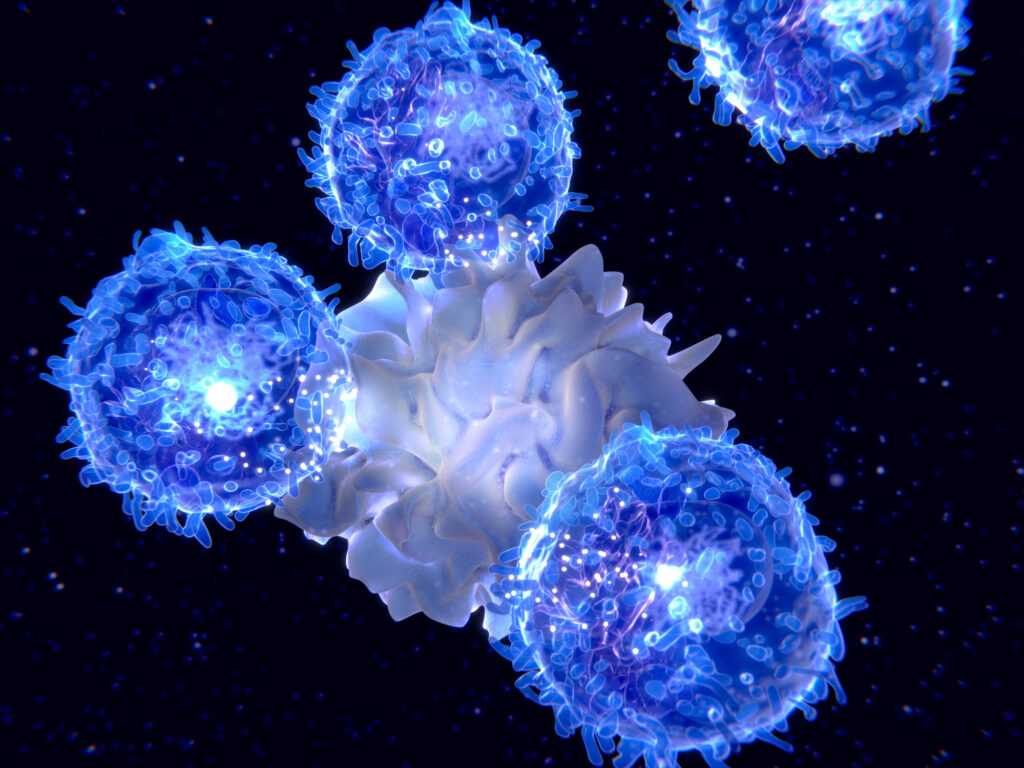Researchers at the University of Cambridge, U.K., have developed a two-part “prodrug” system that can activate the immune system through the Stimulator of Interferon Genes (STING) pathway, allowing it to fight cancer without causing harm to healthy tissues.
Published in the journal Nature Chemistry with the title “Tumor-specific STING agonist synthesis via a two-component prodrug system,” the research focuses on a specific pathway in our cells, called the STING pathway, that acts as an internal alarm system. It activates the human innate immune system when the body is attacked by pathogens, such as bacteria and viruses.
When it senses an attack, the mammalian adapter protein STING triggers the production of immunomodulatory type 1 interferons and other pro-inflammatory cytokines. Researchers have long been studying the targeted activation of STING for the treatment of infections, inflammation, and cancer.
However, while there have been promising approaches in activating the STING pathway as a means to treat cancer, many drugs are not targeted enough, creating the danger that the STING pathway is also triggered in healthy tissues, which can cause unwanted and serious side effects.
First author of the study, Nai-Shu Hsu, PhD, of the Yusuf Hamied Department of Chemistry, University of Cambridge, told Inside Precision Medicine in more detail: “The first generation of STING agonists faces issues such as limited cellular permeability and enzymatic degradation from the body’s regulatory mechanisms, which hinder their therapeutic potential.”
“Improving on this are purely synthetic, drug-like STING agonists suitable for systemic or oral administration. However, despite demonstrating promising results in animal models, most STING agonists failed in clinical trials.”
Hsu explained that while the exact causes for the disparities between animal testing and human clinical trial results are not yet understood, researchers believe that the activation of the STING pathway differs in T cells and B cells.
“It has been well-established that excessive STING signaling induces apoptosis and reduces proliferation of T cells, while its activation in B cells could activate anti-inflammatory pathways that counteract the desired antitumor effects,” Hsu said. “Therefore, an emerging direction in the development of STING-based therapeutics is tumor or even cell-type-specific activation to reduce undesired activation.”
Thinking along these lines, the research team designed a two-part “prodrug” system, containing two components that, when they meet in a tumor, activate the STING pathway. This means the immune system is only switched on in the location of the tumor, without affecting healthy tissues.
Prodrugs are a type of inactive compound or medication that only become active when they enter the body and are metabolized into a pharmacologically active drug.
“Our approach is a small molecule-based prodrug strategy, but with a novel mechanism for activation,” Hsu explained. “Most targeted STING activation strategies rely on macromolecule-based delivery systems, such as virus-like particles, exosomes, live bacteria, and antibodies. While each of these has its own merits, we explored alternatives that are purely small molecule-based to see how much tumor-specificity we can get out of such a strategy.”
To explore their new strategy for activating the STING pathway, the research team designed an analog to MSA2, a small-molecule STING agonist originally discovered by scientists at Merck. The team’s MSA2 analog carries a caged component that remains inactive until it comes in contact with an enzyme called β-glucuronidase, which is overexpressed in most tumors, while rarely found in healthy tissues.
“This is like sending two safe packages into the body that only unlock and combine when they meet the tumor’s unique chemistry,” explained lead researcher Gonçalo Bernardes, PhD, professor at the Yusuf Hamied Department of Chemistry, in a press release. “The result is a strong immune-activating drug that appears only where it is needed.”
To validate their findings, the researchers tested the two drug components in laboratory experiments with zebrafish and mouse models. They found that the two components of their drug had almost no activity on their own. Only when the two components met in tumor-like conditions did they form an active compound that successfully activated the STING pathway.
Moreover, the results in the animal models showed that the drug was active mainly in the tumors without attacking vital organs, such as the kidney, liver, and heart.
We hope to provide an alternative way of thinking in designing prodrugs,” Hsu told Inside Precision Medicine. “We have shown that, depending on the properties of the reactant, it may be possible to devise simple reacting pairs that work equally well, if not better, in complex in vivo environments compared to well-established bioorthogonal reactions.”
“As most bioactive compounds are sensitive to subtle changes in their structures, the individual components are likely to be far less active compared to the product they form, which provides further opportunities for precise activations and increased safety profiles.”
The research team believes that their new prodrug system could be used beyond cancer treatment and may help to develop a new class of precision medicines for other conditions where strong drugs have to be delivered safely to targets without harming healthy tissues.
“This discovery is exciting not only for cancer treatment, but also as a new way of thinking about how we make medicines safer and more precise,” Hsu concluded.

